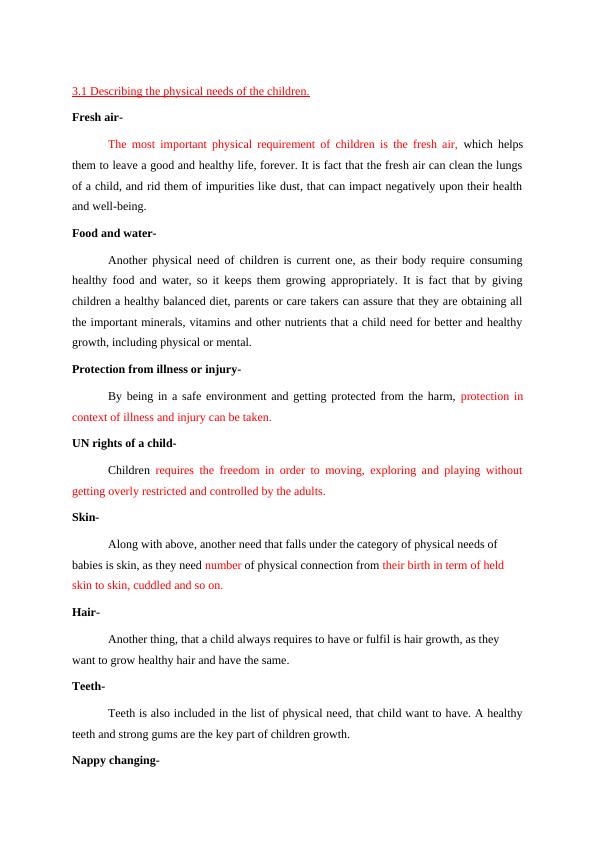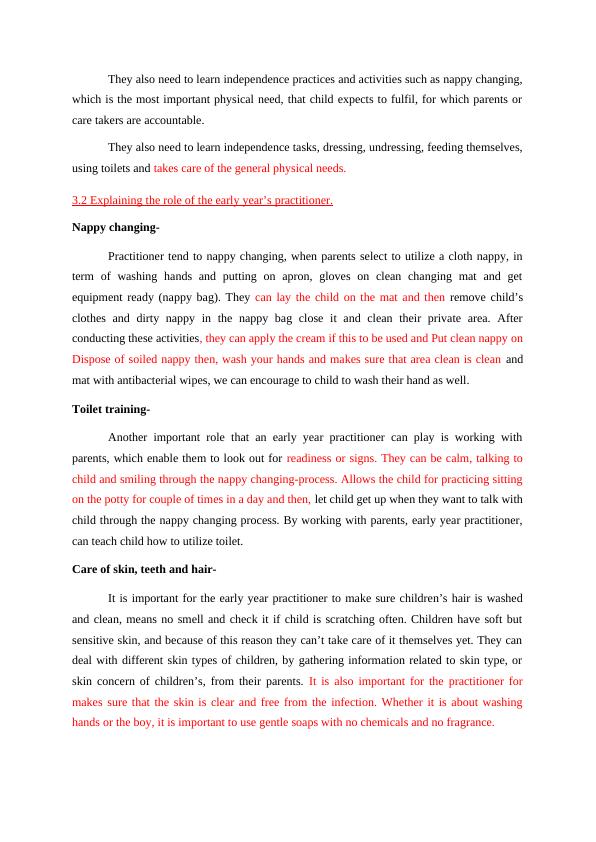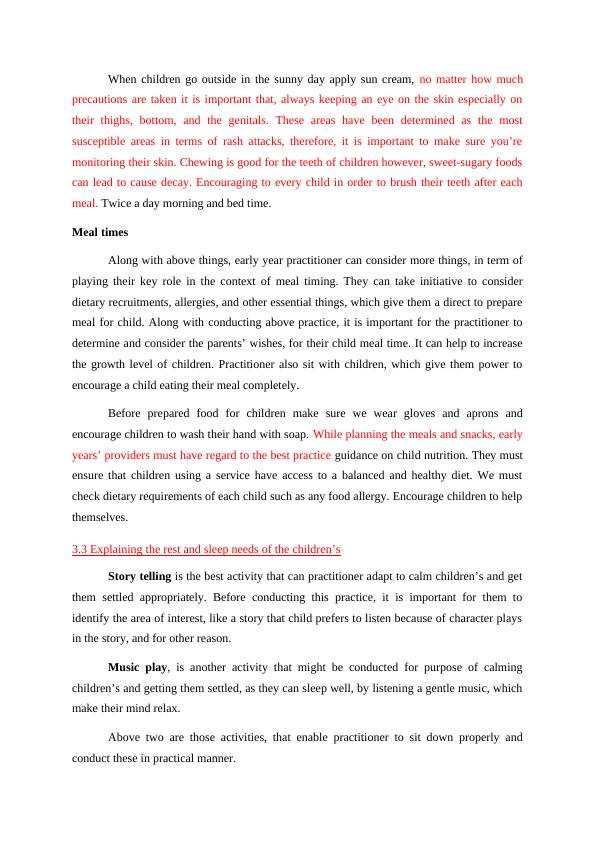Physical Needs, Role of Practitioner, Rest and Sleep Needs, Safety Precautions for Children
Added on 2023-06-04
6 Pages1656 Words357 Views
3.1 Describing the physical needs of the children.
Fresh air-
The most important physical requirement of children is the fresh air, which helps
them to leave a good and healthy life, forever. It is fact that the fresh air can clean the lungs
of a child, and rid them of impurities like dust, that can impact negatively upon their health
and well-being.
Food and water-
Another physical need of children is current one, as their body require consuming
healthy food and water, so it keeps them growing appropriately. It is fact that by giving
children a healthy balanced diet, parents or care takers can assure that they are obtaining all
the important minerals, vitamins and other nutrients that a child need for better and healthy
growth, including physical or mental.
Protection from illness or injury-
By being in a safe environment and getting protected from the harm, protection in
context of illness and injury can be taken.
UN rights of a child-
Children requires the freedom in order to moving, exploring and playing without
getting overly restricted and controlled by the adults.
Skin-
Along with above, another need that falls under the category of physical needs of
babies is skin, as they need number of physical connection from their birth in term of held
skin to skin, cuddled and so on.
Hair-
Another thing, that a child always requires to have or fulfil is hair growth, as they
want to grow healthy hair and have the same.
Teeth-
Teeth is also included in the list of physical need, that child want to have. A healthy
teeth and strong gums are the key part of children growth.
Nappy changing-
Fresh air-
The most important physical requirement of children is the fresh air, which helps
them to leave a good and healthy life, forever. It is fact that the fresh air can clean the lungs
of a child, and rid them of impurities like dust, that can impact negatively upon their health
and well-being.
Food and water-
Another physical need of children is current one, as their body require consuming
healthy food and water, so it keeps them growing appropriately. It is fact that by giving
children a healthy balanced diet, parents or care takers can assure that they are obtaining all
the important minerals, vitamins and other nutrients that a child need for better and healthy
growth, including physical or mental.
Protection from illness or injury-
By being in a safe environment and getting protected from the harm, protection in
context of illness and injury can be taken.
UN rights of a child-
Children requires the freedom in order to moving, exploring and playing without
getting overly restricted and controlled by the adults.
Skin-
Along with above, another need that falls under the category of physical needs of
babies is skin, as they need number of physical connection from their birth in term of held
skin to skin, cuddled and so on.
Hair-
Another thing, that a child always requires to have or fulfil is hair growth, as they
want to grow healthy hair and have the same.
Teeth-
Teeth is also included in the list of physical need, that child want to have. A healthy
teeth and strong gums are the key part of children growth.
Nappy changing-

They also need to learn independence practices and activities such as nappy changing,
which is the most important physical need, that child expects to fulfil, for which parents or
care takers are accountable.
They also need to learn independence tasks, dressing, undressing, feeding themselves,
using toilets and takes care of the general physical needs.
3.2 Explaining the role of the early year’s practitioner.
Nappy changing-
Practitioner tend to nappy changing, when parents select to utilize a cloth nappy, in
term of washing hands and putting on apron, gloves on clean changing mat and get
equipment ready (nappy bag). They can lay the child on the mat and then remove child’s
clothes and dirty nappy in the nappy bag close it and clean their private area. After
conducting these activities, they can apply the cream if this to be used and Put clean nappy on
Dispose of soiled nappy then, wash your hands and makes sure that area clean is clean and
mat with antibacterial wipes, we can encourage to child to wash their hand as well.
Toilet training-
Another important role that an early year practitioner can play is working with
parents, which enable them to look out for readiness or signs. They can be calm, talking to
child and smiling through the nappy changing-process. Allows the child for practicing sitting
on the potty for couple of times in a day and then, let child get up when they want to talk with
child through the nappy changing process. By working with parents, early year practitioner,
can teach child how to utilize toilet.
Care of skin, teeth and hair-
It is important for the early year practitioner to make sure children’s hair is washed
and clean, means no smell and check it if child is scratching often. Children have soft but
sensitive skin, and because of this reason they can’t take care of it themselves yet. They can
deal with different skin types of children, by gathering information related to skin type, or
skin concern of children’s, from their parents. It is also important for the practitioner for
makes sure that the skin is clear and free from the infection. Whether it is about washing
hands or the boy, it is important to use gentle soaps with no chemicals and no fragrance.
which is the most important physical need, that child expects to fulfil, for which parents or
care takers are accountable.
They also need to learn independence tasks, dressing, undressing, feeding themselves,
using toilets and takes care of the general physical needs.
3.2 Explaining the role of the early year’s practitioner.
Nappy changing-
Practitioner tend to nappy changing, when parents select to utilize a cloth nappy, in
term of washing hands and putting on apron, gloves on clean changing mat and get
equipment ready (nappy bag). They can lay the child on the mat and then remove child’s
clothes and dirty nappy in the nappy bag close it and clean their private area. After
conducting these activities, they can apply the cream if this to be used and Put clean nappy on
Dispose of soiled nappy then, wash your hands and makes sure that area clean is clean and
mat with antibacterial wipes, we can encourage to child to wash their hand as well.
Toilet training-
Another important role that an early year practitioner can play is working with
parents, which enable them to look out for readiness or signs. They can be calm, talking to
child and smiling through the nappy changing-process. Allows the child for practicing sitting
on the potty for couple of times in a day and then, let child get up when they want to talk with
child through the nappy changing process. By working with parents, early year practitioner,
can teach child how to utilize toilet.
Care of skin, teeth and hair-
It is important for the early year practitioner to make sure children’s hair is washed
and clean, means no smell and check it if child is scratching often. Children have soft but
sensitive skin, and because of this reason they can’t take care of it themselves yet. They can
deal with different skin types of children, by gathering information related to skin type, or
skin concern of children’s, from their parents. It is also important for the practitioner for
makes sure that the skin is clear and free from the infection. Whether it is about washing
hands or the boy, it is important to use gentle soaps with no chemicals and no fragrance.

When children go outside in the sunny day apply sun cream, no matter how much
precautions are taken it is important that, always keeping an eye on the skin especially on
their thighs, bottom, and the genitals. These areas have been determined as the most
susceptible areas in terms of rash attacks, therefore, it is important to make sure you’re
monitoring their skin. Chewing is good for the teeth of children however, sweet-sugary foods
can lead to cause decay. Encouraging to every child in order to brush their teeth after each
meal. Twice a day morning and bed time.
Meal times
Along with above things, early year practitioner can consider more things, in term of
playing their key role in the context of meal timing. They can take initiative to consider
dietary recruitments, allergies, and other essential things, which give them a direct to prepare
meal for child. Along with conducting above practice, it is important for the practitioner to
determine and consider the parents’ wishes, for their child meal time. It can help to increase
the growth level of children. Practitioner also sit with children, which give them power to
encourage a child eating their meal completely.
Before prepared food for children make sure we wear gloves and aprons and
encourage children to wash their hand with soap. While planning the meals and snacks, early
years’ providers must have regard to the best practice guidance on child nutrition. They must
ensure that children using a service have access to a balanced and healthy diet. We must
check dietary requirements of each child such as any food allergy. Encourage children to help
themselves.
3.3 Explaining the rest and sleep needs of the children’s
Story telling is the best activity that can practitioner adapt to calm children’s and get
them settled appropriately. Before conducting this practice, it is important for them to
identify the area of interest, like a story that child prefers to listen because of character plays
in the story, and for other reason.
Music play, is another activity that might be conducted for purpose of calming
children’s and getting them settled, as they can sleep well, by listening a gentle music, which
make their mind relax.
Above two are those activities, that enable practitioner to sit down properly and
conduct these in practical manner.
precautions are taken it is important that, always keeping an eye on the skin especially on
their thighs, bottom, and the genitals. These areas have been determined as the most
susceptible areas in terms of rash attacks, therefore, it is important to make sure you’re
monitoring their skin. Chewing is good for the teeth of children however, sweet-sugary foods
can lead to cause decay. Encouraging to every child in order to brush their teeth after each
meal. Twice a day morning and bed time.
Meal times
Along with above things, early year practitioner can consider more things, in term of
playing their key role in the context of meal timing. They can take initiative to consider
dietary recruitments, allergies, and other essential things, which give them a direct to prepare
meal for child. Along with conducting above practice, it is important for the practitioner to
determine and consider the parents’ wishes, for their child meal time. It can help to increase
the growth level of children. Practitioner also sit with children, which give them power to
encourage a child eating their meal completely.
Before prepared food for children make sure we wear gloves and aprons and
encourage children to wash their hand with soap. While planning the meals and snacks, early
years’ providers must have regard to the best practice guidance on child nutrition. They must
ensure that children using a service have access to a balanced and healthy diet. We must
check dietary requirements of each child such as any food allergy. Encourage children to help
themselves.
3.3 Explaining the rest and sleep needs of the children’s
Story telling is the best activity that can practitioner adapt to calm children’s and get
them settled appropriately. Before conducting this practice, it is important for them to
identify the area of interest, like a story that child prefers to listen because of character plays
in the story, and for other reason.
Music play, is another activity that might be conducted for purpose of calming
children’s and getting them settled, as they can sleep well, by listening a gentle music, which
make their mind relax.
Above two are those activities, that enable practitioner to sit down properly and
conduct these in practical manner.

End of preview
Want to access all the pages? Upload your documents or become a member.
Related Documents
Early Year Practitioner for Child Care : Reportlg...
|8
|2054
|46
CHCECE005 Provide care for babies and toddlerslg...
|6
|1296
|95
Assessment tasks on childcarelg...
|6
|659
|120
Safe Sleeping Practices for Toddlers and Other Essential Childcare Practiceslg...
|16
|3060
|69
